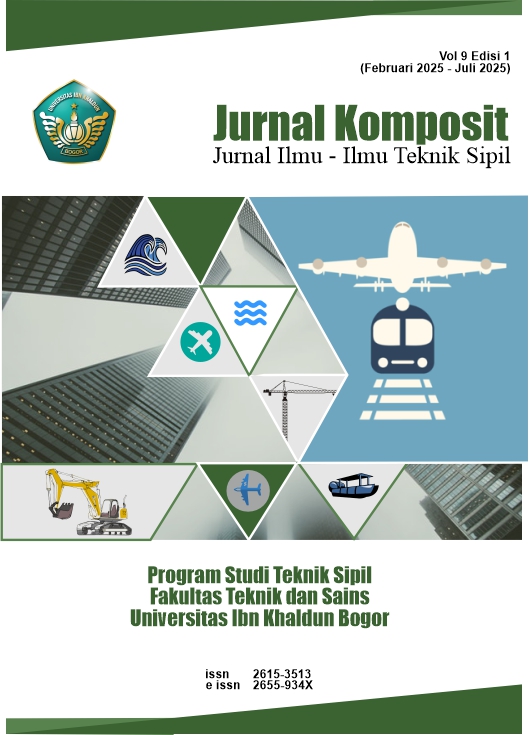Analisa Debit Banjir Rencana DAS Rejoso Menggunakan Metode Hidrograf Satuan Sintetik Nakayasu
DOI:
https://doi.org/10.32832/komposit.v9i1.17597Keywords:
Debit Banjir Rencana, HSS Nakayasu, DAS RejosoAbstract
Flood is an event where water overflows in a river beyond its capacity. Several areas in Indonesia, especially Pasuruan Regency, often experience flooding, one of which is the Rejoso Watershed which often experiences flooding every year. Therefore, efforts need to be made to immediately minimize the occurrence of flood disasters. By planning water structures, planned flood discharge data is needed as a basis for planning the dimensions and stability of water structures. In this study, the hydrological analysis begins by calculating the average rainfall in the area using the Thieseen polygon method, the analysis of return period rainfall using the Gumbel method which is tested using the chi-square method, then the analysis of rainfall intensity using the Mononobe method, and the hydrograph analysis using the HSS Nakaysu method. The results of the study stated that the peak discharge of the Rejoso Watershed for return periods of 2, 5, and 10 years, respectively, was 769.32 m3/sec; 971.62 m3/sec and 1116.96 m3/sec. In the period of 25, 50 and 100 years respectively, namely 1274.80 m3/sec; 1400.35 m3/sec and 1524.97 m3/sec. The planned flood discharge of the Rejoso watershed began to experience an increase in the curve at hour 0 to hour 2. While the peak discharge occurred at hour 2. At hour 3, the flood discharge of the Rejoso watershed began to experience a decrease in the curve until hour 13.
References
Arifin, M. (2024). Tiga Desa di Winongan Pasuruan Banjir Luapan Sungai Rejoso.
Dori, S. A. (2020). Identifikasi Wilayah Rawan Genangan Banjir, Penyebab dan Upaya Penanggulangannya di Nagari Campago Kabupaten Padang Pariaman. Universitas Andalas.
http://scholar.unand.ac.id/55790/
Fattah, S. M. R. (2018). Analisis Penggunaan Metode HSS Nakayasu untuk Pengendalian Banjir Kelurahan Sei Sikambing C II Kecamatan Helvetia Kota Medan [Universitas Muhammadiyah Sumatera Utara]. http://repository.umsu.ac.id/handle/123456789/8632?show=full
Hendri, A. (2015). Analisis Metode Intensitas Hujan pada Stasiun Hujan Pasar Kampar Kabupaten Kampar. Annual Civil Engineering Seminar, 297–304.
Junaedi, M., & Hidayati, N. (2011). Perencanaan Retarding Pond Kota Purwodadi [Universitas Diponogoro].
eprints.undip.ac.id/34478/3/2194
Junia, N., Fauzi, M., & Suprayogi, I. (2015). Kesesuain Model Hidrograf Satuan Sintetik Studi Kasus Sub Daerah Aliran Sungai Siak Bagian Hulu. Jurnal Online Mahasisiwa (JOM) Fakultas Teknik, 2(1), 1–9. https://jom.unri.ac.id/index.php/JOMFTEKNIK/article/view/6432
Karina, F. V., Sukarno, S., & Hendratta, L. A. (2019). Kajian Teknis Model Pengambilan Air Berdasarkan Debit Andalan di Sungai Paniki. Jurnal Sipil Statik, 7(2), 251–256.
https://ejournal.unsrat.ac.id/v2/index.php/jss/article/view/22795
Maulidiyah, A. (2019). Studi Potensi Debit Run Off DAS Kali Welang Menggunakan Metode Simulasi Hujan-Limpasan FJ Mock. Jurnal Konstruksi Sipil, 7(1), 1–11.
https://jurnal.yudharta.ac.id/v2/index.php/konstruksi/article/view/2777
Iqbal, T. M. (2020). Tingkat Kerentanan Wilayah terhadap Banjir di Kecamatan Rumbai. Garuda, 1, 1–12.
https://etd.uir.ac.id/index.php?p=show_detail&id=13436&keywords=
Pramesti, M. Y., Asmaranto, R., & Fidari, J. S. (2023). Studi Evaluasi Saluran Drainase terhadap Genangan Banjir di Kelurahan Blimbing Menggunakan Model EPA SWMM 5.1. Jurnal Teknologi dan Rekayasa Sumber Daya Air, 3(2), 476–489.
https://doi.org/10.21776/ub.jtresda.2023.003.02.041
Ramadani, A., & Warsito, A. R. (2020). Studi Perencanaan Dimensi Tubuh Bendungan pada Bendungan Logung Kabupaten Kudus. Jurnal Rekayasa Sipil, 8(1), 52–64.
https://jim.unisma.ac.id/index.php/ft/article/view/5624
Ramadi, T. (2023). Analisis Kebutuhan Air Irigasi Menggunakan Cropwat 8.0 pada Daerah Irigasi Siulak Deras Kabupatenn Kerinci. Universitas Jambi.
https://repository.unja.ac.id/53351/
Retnowati, D., Lasminto, U., & Savitri, Y. R. (2015). Studi Pengendalian Banjir dan Genangan pada Sistem Drainase Kali Pucang Sidoarjo. Jurnal Hidroteknik, 1(1), 21.
https://doi.org/10.12962/jh.v1i1.1660
Saifudin, I., Suripin, S., & Suharyanto, S. (2017). Kajian Respon Perubahan Penggunaan Lahan terhadap Karakteristik Hidrologi DAS Garang [Universitas Diponogoro].
http://eprints.undip.ac.id/55640/
Saputra, L., Hariati, F., & Alimuddin, A. (2018). Analisis Kapasitas Sungai Ciparigi terhadap Debit Banjir Kala Ulang. Jurnal Komposit: Jurnal Ilmu-Ilmu Teknik Sipil, 2(2), 100.
https://doi.org/10.32832/komposit.v2i2.1556
Sarminingsih, A. (2018). Pemilihan Metode Analisis Debit Banjir Rancangan Embung Coyo Kabupaten Grobogan. Jurnal Presipitasi: Media Komunikasi dan Pengembangan Teknik Lingkungan, 15(1), 53–61. https://doi.org/10.14710/jis.%v.%i.%Y.585-595
Satriadi, I. (2017). Analisis Hidrograf Banjir Saluran Irigasi Cibalok Bogor. Astonjadro, 6(1), 49–59. https://doi.org/10.32832/astonjadro.v6i1.2261
Suyanto, S., & Maulidiyah, A. (2023). Analisis Kapasitas Saluran Drainase Calung Dalam Penanganan Banjir Di Kota Pasuruan. Composite: Journal of Civil Engineering, 2(2), 44–55.
https://doi.org/10.26905/JTSC.V2I2.10925
Taqwa, F. M. L. (2017). Perencanaan Normalisasi Arus Sungai Cijere di Desa Pasirmukti Kec. Citeureup Kab. Bogor. Jurnal Komposit: Jurnal Ilmu-Ilmu Teknik Sipil, 1(2), 31–43.
https://doi.org/http://doi.org/10.32832/komposit.v1i2.1544
Utama, L. (2018). Kajian Morphometri Pada Daerah Aliran Sungai (Das) Batang Kuranji Terhadap Debit Banjir. Frontiers: Jurnal Sains Dan Teknologi, 1(April).
https://doi.org/10.36412/frontiers/001035e1/april201801.07
Wibisono, G. R., Paranindya, A. A., Santosa, B., & Suwarno, D. (2023). Potensi Penurunan Debit Banjir Di Sungai Jragung Akibat Pembangunan Bendungan Jragung. G-Smart, 7(1), 45–54.
https://doi.org/10.24167/gsmart.v7i1.10079
Yuliana, Y. (2023). Analisis Banjir Rancangan Menggunakan Metode Hidrograf Satuan Sintetis Nakayasu dan Metode Rasional pada DAS Pengabuan Kabupaten Tanjung Jabung Barat [Universitas Jambi].
Downloads
Published
How to Cite
Issue
Section
License
Copyright (c) 2025 Jurnal Komposit: Jurnal Ilmu-ilmu Teknik Sipil

This work is licensed under a Creative Commons Attribution-NonCommercial-ShareAlike 4.0 International License.
Authors who publish with this journal agree to the following terms (Penulis yang mengajukan publikasi artikel telah menyetujui hal berikut):
- Through this publication, the author agree to submit the copyright of article writing to Jurnal Komposit: Jurnal Ilmu-ilmu Teknik Sipil. This copyright submission takes the form of, but is not limited to: reproduction of the article and parts therein, including photographic reproductions; distribution of articles through printed and electronic documents; and translation of articles(Bahwa melalui publikasi ini, hak cipta penulisan artikel diserahkan kepada Jurnal Komposit: Jurnal Ilmu-ilmu Teknik Sipil. Penyerahan hak cipta ini berupa, namun tidak terbatas pada: perbanyakan artikel dan bagian di dalamnya, termasuk reproduksi fotografi; penyebarluasan artikel melalui dokumen cetak dan elektronik; serta penterjemahan artikel).
- The authors agree to the terms of the Copyright Notice, according to Creative Commons Attribution-NonCommercial-ShareAlike 4.0 International License., which will apply to this article if and when it is published by Jurnal Komposit: Jurnal Ilmu-ilmu Teknik Sipil. (Para penulis setuju dengan ketentuan Pemberitahuan Hak Cipta, sesuai dengan Lisensi Internasional Creative Commons Attribution-NonCommercial-ShareAlike 4.0., yang akan berlaku untuk artikel ini jika dan ketika diterbitkan oleh Jurnal Komposit: Jurnal Ilmu-ilmu Teknik Sipil).

This work is licensed under a Creative Commons Attribution-NonCommercial-ShareAlike 4.0 International License.



.png)










